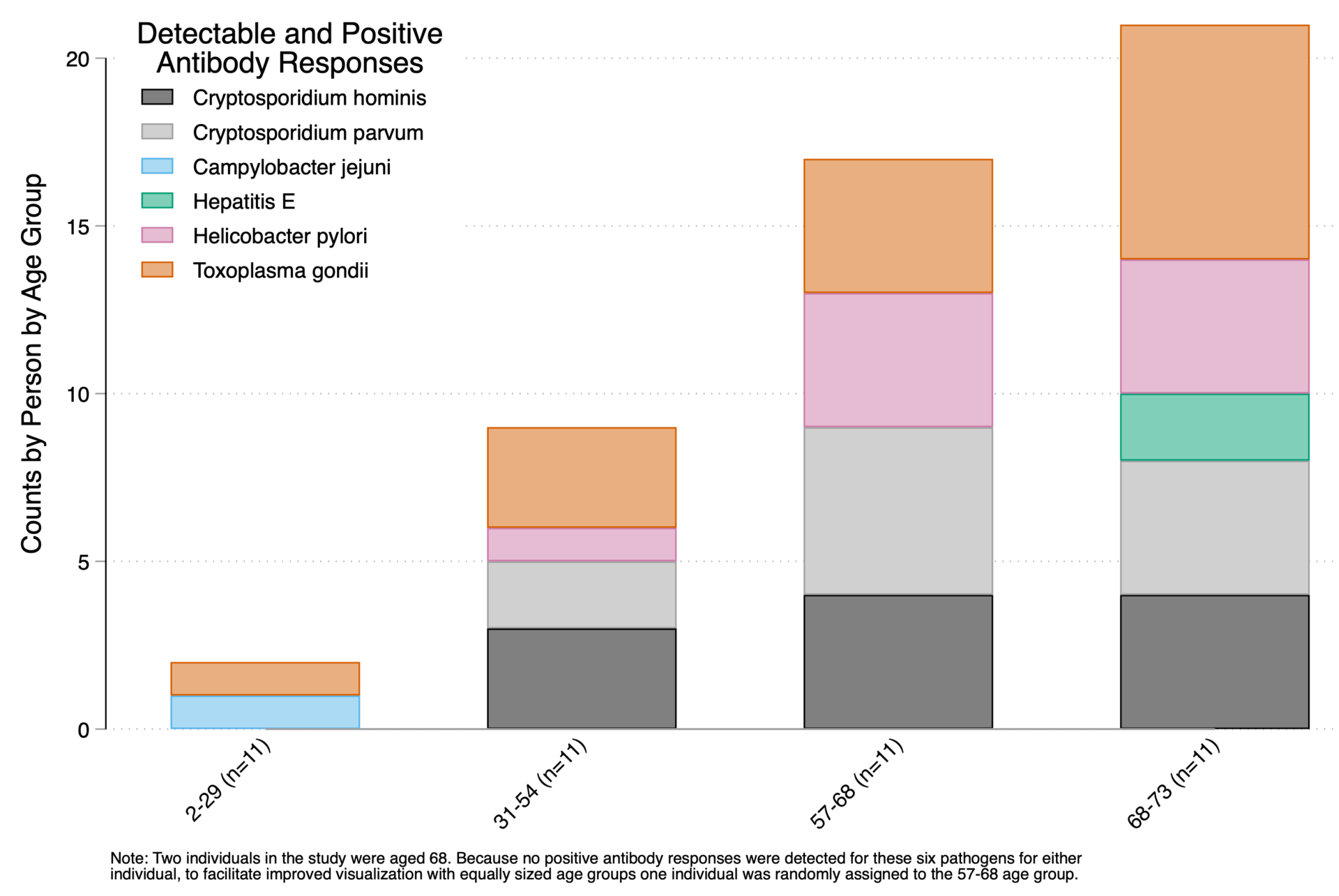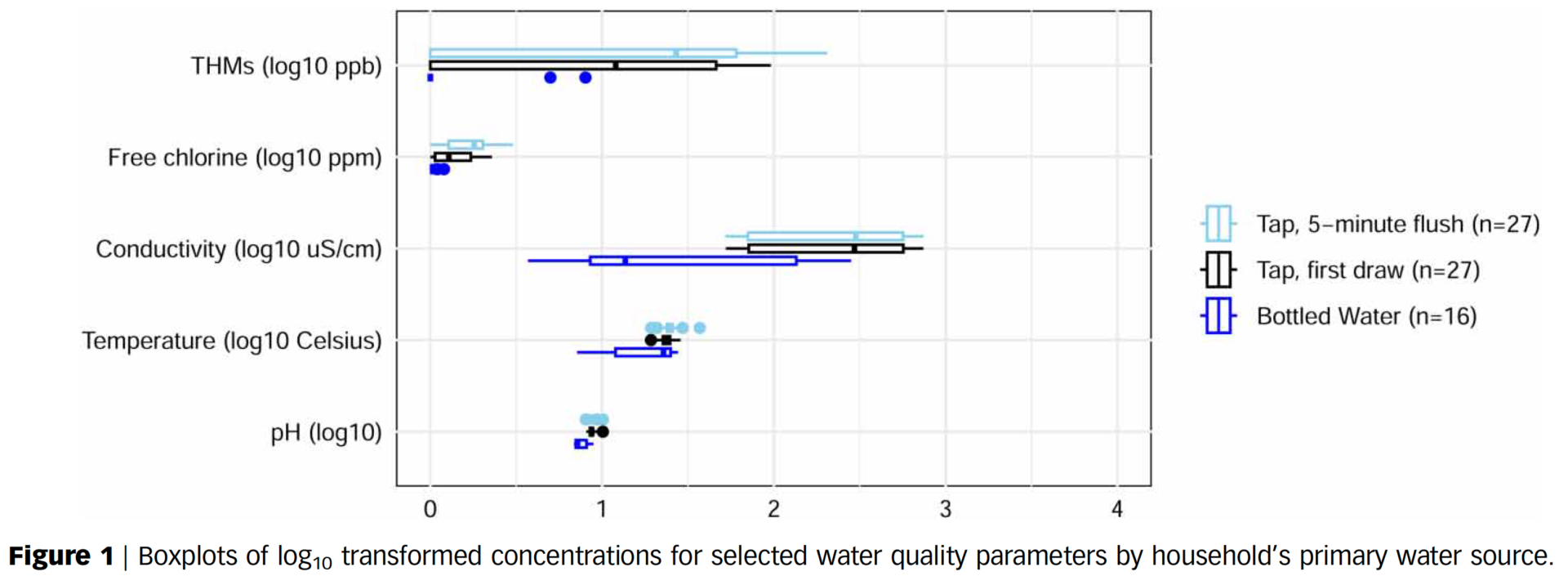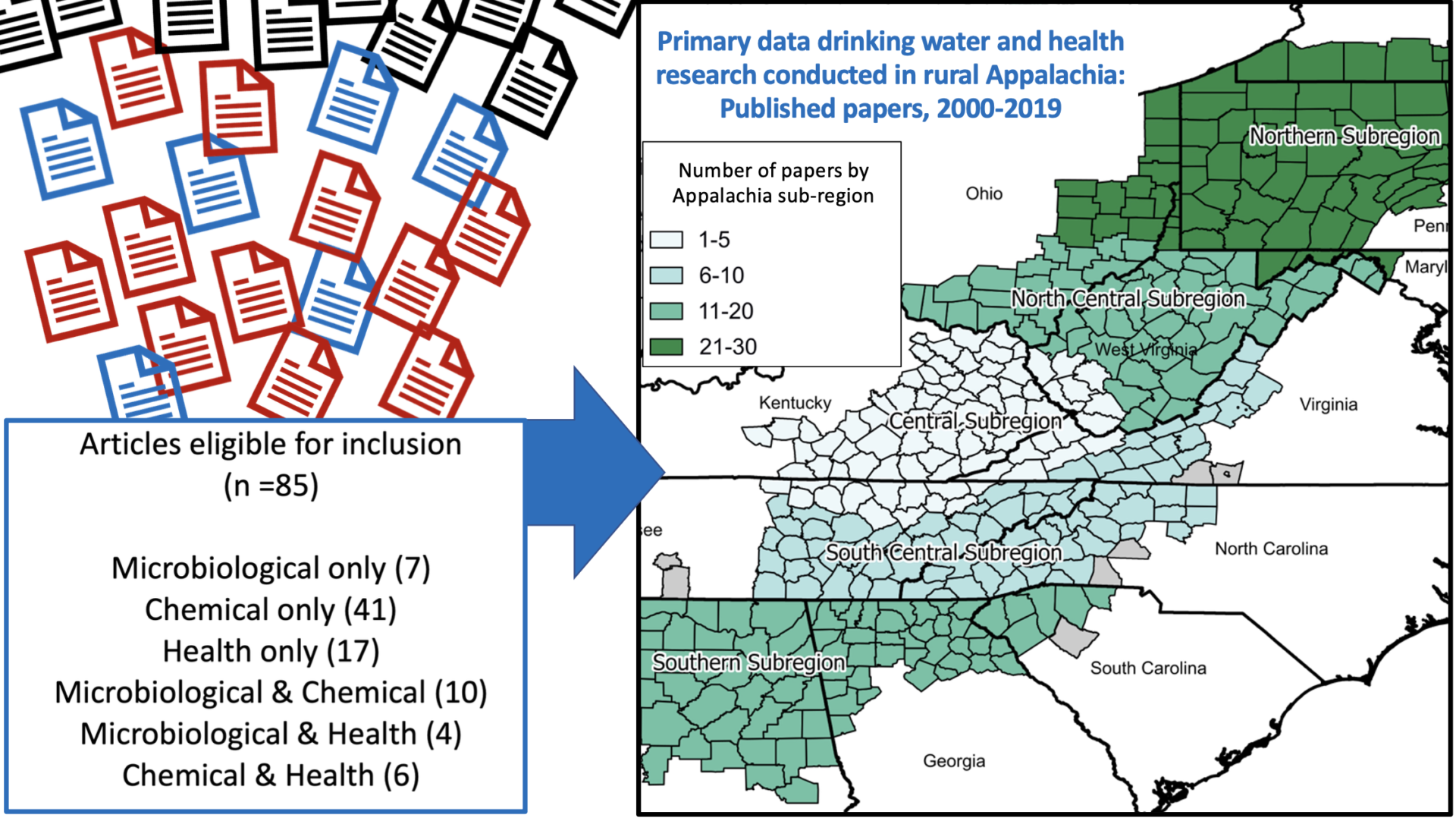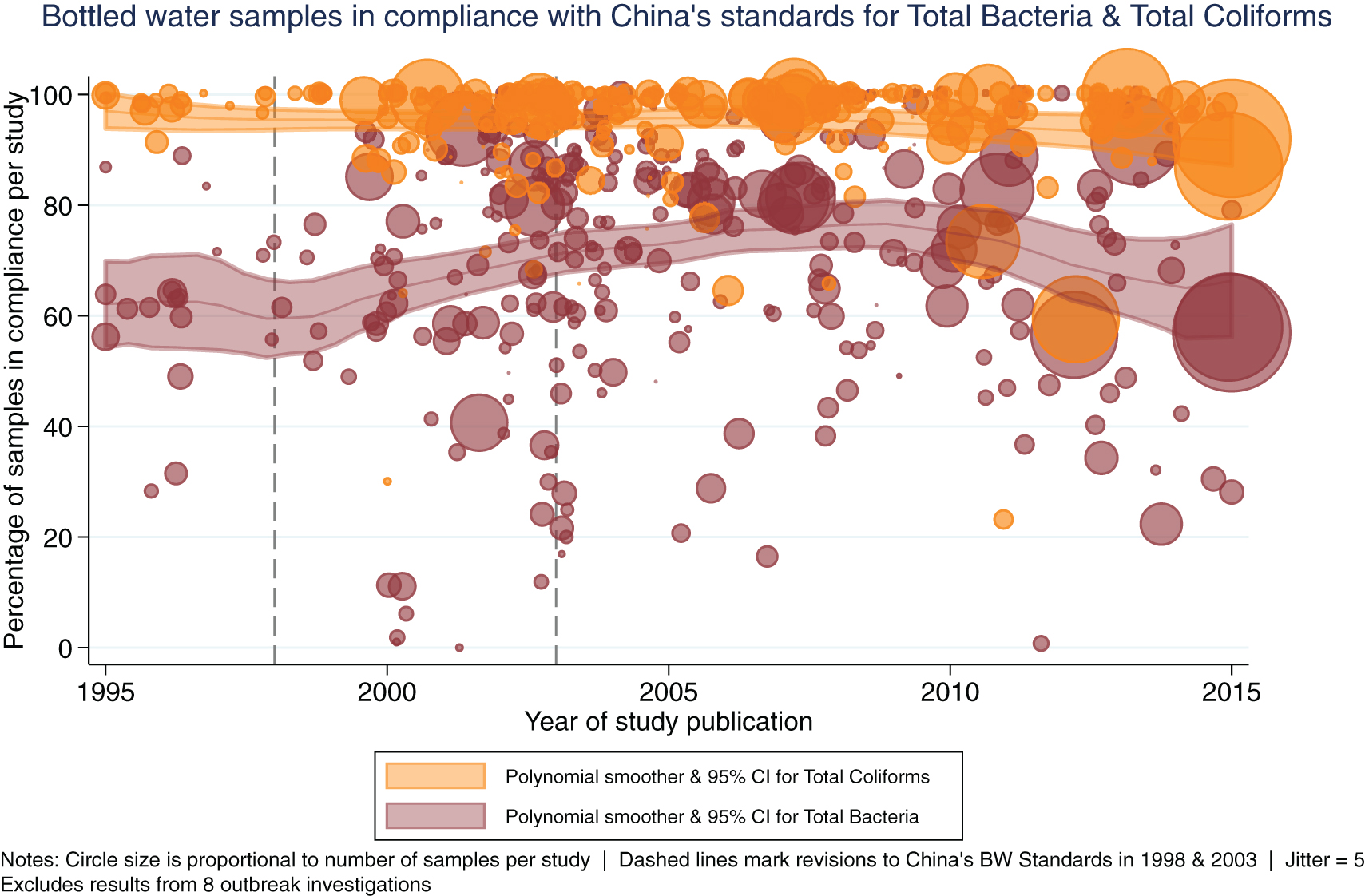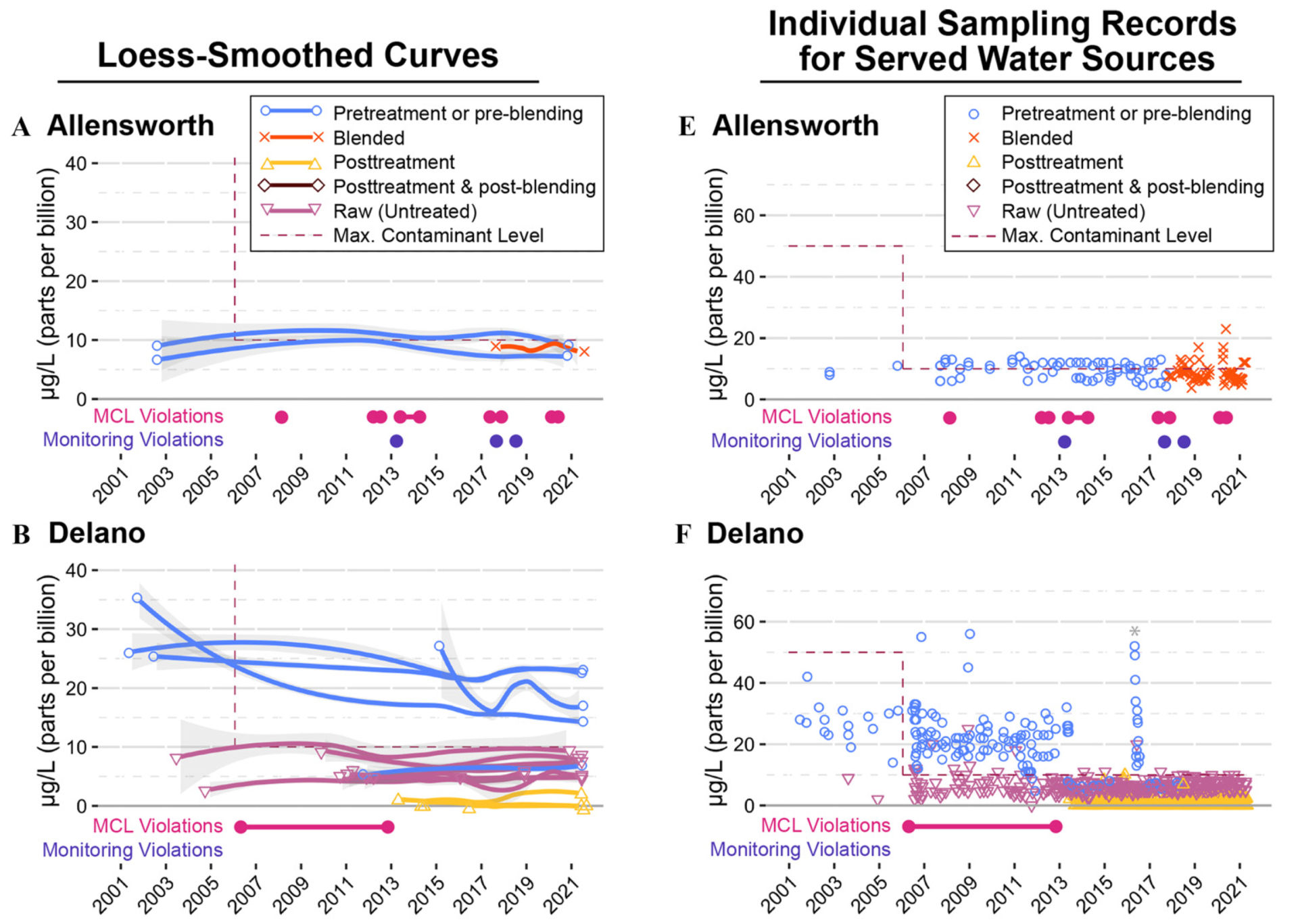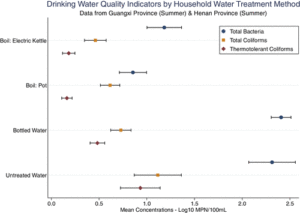Drinking water sources, quality, and associated health outcomes in Appalachian Virginia: A risk characterization study in two counties
Authors: Cohen*, Rasheduzzaman, O’Connell, Brown, Taniuchi, Krometis, Hubbard, Scheuerman, Edwards, Darling, Pennala, Price, Lytton, Wettstone, Pholwat, Ward, Hallinger, Simmons, Griffin, Kobylanski, Egorov, & Wade
Publication Year: 2024 | Journal / Publisher: International Journal of Hygiene and Environmental Health
Abstract/Summary: In the US, violations of drinking water regulations are highest in lower-income rural areas overall, and particularly in Central Appalachia. However, data on drinking water use, quality, and associated health outcomes in rural Appalachia are limited. We sought to assess public and private drinking water sources and associated risk factors for waterborne pathogen exposures for individuals living in rural regions of Appalachian Virginia. We administered surveys and collected tap water, bottled water, and saliva samples in lower-income households in two adjacent rural counties in southwest Virginia (bordering Kentucky and Tennessee). Water samples were tested for pH, temperature, conductivity, total coliforms, E. coli, free chlorine, nitrate, fluoride, heavy metals, and specific pathogen targets. Saliva samples were analyzed for antibody responses to potentially waterborne infections. We also shared water analysis results with households. We enrolled 33 households (83 individuals), 82% (n = 27) with utility-supplied water and 18% with private wells (n = 3) or springs (n = 3). 58% (n = 19) reported household incomes of <$20,000/year. Total coliforms were detected in water samples from 33% (n = 11) of homes, E. coli in 12%, all with wells or springs (n = 4), and Aeromonas, Campylobacter, and Enterobacter in 9%, all spring water (n = 3). Diarrhea was reported for 10% of individuals (n = 8), but was not associated with E. coli detection. 34% (n = 15) of saliva samples had detectable antibody responses for Cryptosporidium spp., C. jejuni, and Hepatitis E. After controlling for covariates and clustering, individuals in households with septic systems and straight pipes had significantly higher likelihoods of antibody detection (risk ratios = 3.28, 95%CI = 1.01–10.65). To our knowledge, this is the first study to collect and analyze drinking water samples, saliva samples, and reported health outcome data from low-income households in Central Appalachia. Our findings indicate that utility-supplied water in this region was generally safe, and individuals in low-income households without utility-supplied water or sewerage have higher exposures to waterborne pathogens.
PDF on Publisher Website | PDF on OSF
Point-of-use chlorine residuals and disinfection byproduct occurrences in rural households served by public water utilities in Appalachian Virginia
Authors: Rasheduzzaman, M, O’Connell, B., Krometis, L.-A., Brown, T., & Cohen, A.*
Publication Year: 2024 | Journal / Publisher: Journal of Water and Health
Abstract/Summary: We characterized concentrations of trihalomethanes (THMs), a measure of disinfection byproducts (DBPs), in tap water samples collected from households with utility-supplied water in two rural counties in Appalachian Virginia, and assessed associations with pH, free chlorine, and metal ions which can impact THM formation. Free chlorine concentrations in all samples (n = 27 homes) complied with EPA drinking water guidelines, though 7% (n = 2) of first draw samples and 11% (n = 3) of 5-min flushed-tap water samples exceeded the US Safe Drinking Water Act (SDWA) maximum contaminant level (MCL) for THM (80 ppb). Regression analyses showed that free chlorine and pH were positively associated with the formation of THM levels above SDWA MCLs (OR = 1.04, p = 0.97 and OR = 1.74, p = 0.79, respectively), while temperature was negatively associated (OR = 0.78, p = 0.38). Of the eight utilities serving study households, samples from water served by three different utilities exceeded the EPA MCL for THM. Overall, these findings do not indicate substantial exposures to DBPs for rural households with utility-supplied water in this region of southwest Virginia. However, given the observed variability in THM concentrations between and across utilities, and established adverse health impacts associated with chronic and acute DBP exposure, more research on DBPs in rural Central Appalachia is warranted.
PDF on Publisher Website | PDF on OSF
Microbiological and chemical drinking water contaminants and associated health outcomes in rural Appalachia, USA: A systematic review and meta-analysis
Authors: Darling A., Patton H., Rasheduzzaman M., Guevera R., McCray J., Krometis L.A., & Cohen, A.
Publication Year: 2023 | Journal / Publisher: Science of The Total Environment
Abstract/Summary: In rural areas of the United States, an estimated ~1.8 million people lack reliable access to safe drinking water. Considering the relative dearth of information on water contamination and health outcomes in Appalachia, we conducted a systematic review of primary data studies published from 2000-2019. Of the 3,452 records identified for screening, 85 met our eligibility criteria. Most studies were conducted in Northern (32%, n=27) and North Central (24%, n=20) Appalachia, and only 6% (n=5) in Central Appalachia. Across studies, E. coli were detected in 10.6% of samples. 32% (n=27) of studies assessed health outcomes, but only 4.7% (n=4) used case-control or cohort designs (all others were cross-sectional). The most commonly reported outcomes were detection of PFAS in blood serum (n=13), gastrointestinal illness (n=5), and cardiovascular-related outcomes (n=4). Overall, based on the number and quality of eligible studies identified, we could not reach clear conclusions about the state of water quality, or its impacts on health, in any of Appalachia’s subregions. More epidemiologic research is needed to understand contaminated water sources, exposures, and potentially associated health outcomes in Appalachia.
PDF on Publisher Website | PDF on OSF
Bottled and Well Water Quality in a Small Central Appalachian Community: Household-Level Analysis of Enteric Pathogens, Inorganic Chemicals, and Health Outcomes in Rural Southwest Virginia
Authors: Cohen, A., Rasheduzzaman, M., Darling, A., Krometis, L.-A., Edwards, M., Brown, T., Ahmed, T., Wettstone, E., Pholwat, S., Taniuchi, M., & Rogawski McQuade, E. T.
Publication Year: 2022 | Journal / Publisher: International Journal of Environmental Research & Public Health
Abstract/Summary: Consumption of unsafe drinking water is associated with a substantial burden of disease globally. In the US, ~1.8 million people in rural areas lack reliable access to safe drinking water. Our objective was to characterize and assess household-level water sources, water quality, and associated health outcomes in Central Appalachia. We collected survey data and water samples (tap, source, and bottled water) from consenting households in a small rural community without utility-supplied water in southwest Virginia. Water samples were analyzed for physicochemical parameters, total coliforms, E. coli, nitrate, sulfate, metals (e.g., arsenic, cadmium, lead), and 30+ enteric pathogens. Among the 69% (n = 9) of households that participated, all had piped well water, though 67% (n = 6) used bottled water as their primary drinking water source. Total coliforms were detected in water samples from 44.4% (n = 4) of homes, E. coli in one home, and enteric pathogens (Aeromonas, Campylobacter, Enterobacter) in 33% (n = 3) of homes. Tap water samples from 11% (n = 1) of homes exceeded the EPA MCL for nitrate, and 33% (n = 3) exceeded the EPA SMCL for iron. Among the 19 individuals residing in study households, reported diarrhea was 25% more likely in homes with measured E. coli and/or specific pathogens (risk ratio = 1.25, cluster-robust standard error = 1.64, p = 0.865). Although our sample size was small, our findings suggest that a considerable number of lower-income residents without utility-supplied water in rural areas of southwest Virginia may be exposed to microbiological and/or chemical contaminants in their water, and many, if not most, rely on bottled water as their primary source of drinking water.
PDF on Publisher Website | PDF on OSF
Bottled water quality and associated health outcomes: A systematic review and meta-analysis of 20 years of published data from China
Authors: Cohen, A., Cui, J., Song, Q., Xia, Q., Huang, J., Yan, X., Guo, Y., Sun, Y., Colford, J. M., & Ray, I.
Publication Year: 2022 | Journal / Publisher: Environmental Research Letters
Abstract/Summary: Bottled water is a rapidly growing yet relatively understudied source of drinking water globally. In addition to concerns about the safety of bottled water, the adverse environmental health and social impacts associated with bottled water production, distribution, consumption, and reliance are considerable. Our objective was to comprehensively review, analyze, and synthesize ∼20 years of publicly available data on bottled water quality and associated health outcomes in China. We conducted a systematic review and meta-analysis of publicly available studies of bottled water quality and associated health outcomes in China published between 1995 and early 2016 (in Chinese and English). We pre-specified and registered our study protocol, independently replicated key analyses, and followed standardized reporting guidelines. Our search identified 7059 potentially eligible records. Following screening, after full-text review of 476 publications, 216 (reporting results from 625 studies) met our eligibility criteria. Among many findings, 93.7% (SD = 10.1) of 24 585 samples tested for total coliforms (n = 241 studies), and 92.6% (SD = 12.7) of 7261 samples tested for nitrites (n = 85 studies), were in compliance with China’s relevant bottled water standards. Of the studies reporting concentration data for lead (n = 8), arsenic (n = 5), cadmium (n = 3), and mercury (n = 3), median concentrations were within China’s standards for all but one study of cadmium. Only nine publications reported health outcome data, eight of which were outbreak investigations. Overall, we observed evidence of stable or increasing trends in the proportions of samples in compliance over the ∼20 year period; after controlling for other variables via meta-regression, the association was significant for microbiological but not chemical outcomes (p = 0.017 and p = 0.115, respectively). Bottled water is typically marketed as being safe, yet in most countries it is less well-regulated than utility-supplied drinking water. Given the trend of increasing bottled water use in China and globally—and the associated environmental health impacts—we hope this work will help to inform policies and regulations for improving bottled water safety, while further highlighting the need for substantially expanding the provision of safe and affordable utility-supplied drinking water globally.
PDF on Publisher Website | PDF on OSF
The Human Right to Water: A 20-Year Comparative Analysis of Arsenic in Rural and Carceral Drinking Water Systems in California
Authors: Rempel, J., Ray, I., Hessl, E., Vazin, J., Zhou, Z., Kim, S., Zhang, X., Ding, C., He, Z., Pellow, D., & Cohen, A.
Publication Year: 2022 | Journal / Publisher: Environmental Health Perspectives
Abstract/Summary: Access to safe drinking water is considered a universal human right. In the U.S., exposure to arsenic contamination in drinking water disproportionately impacts small, groundwater-reliant communities and communities of color. Limited research exists on water quality in prisons; however, prisons in the Southwestern U.S. have elevated arsenic concentrations compared to other community water systems (CWS) in the region. In this paper we present a comparative analysis of 20 years of data (2001-2021) on arsenic concentrations in the CWSs serving Kern Valley State Prison (KVSP) and three neighboring rural communities: Allensworth, Delano, and McFarland. Our objective was to better understand trends in water quality, compliance, and treatment following adoption of the revised arsenic MCL, and to elucidate differences, if any, between neighboring incarcerated and non-incarcerated populations.
PDF on Publisher Website | PDF on OSF
Water Supply Improvement & Health Promotion Campaigns in Rural Areas — China, 1949−2020
Authors: Li, H., Cohen, A., Lin, L., Zhang, X. & Zhang, R.
Publication Year: 2021 | Journal / Publisher: China CDC Weekly
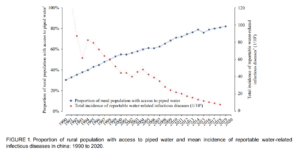 Abstract/Summary: In the 1950s, shortly after the founding of the People’s Republic of China (PRC), the central government created the Patriotic Health Campaign (PHC) in order to standardize and disseminate health focused educational materials intended to control and prevent infectious diseases (1). “Water improvement”, meaning measures aimed at providing safe drinking water for households in China, was an important part of the PHC. After 60 years of water improvement policies, programs, and investments, the rural water supply sanitation and hygiene in China has improved dramatically, and water-related diseases no longer negatively impact the rural population as they once did. In addition to improvements related to the quantity and quality of the rural water supply, water improvement programs also promoted improved hygiene, sanitation, and other health-related behaviors among rural households. Together, such initiatives have improved the quality of life and the health of hundreds of millions of rural residents, while also contributing to economic and social advancement across rural China (2). The purpose of this article is to describe how the PHC served as a foundation for the expansion and improvement of drinking water supply in rural China, and to summarize the key programs, projects, and initiatives that followed over the last 60 years.
Abstract/Summary: In the 1950s, shortly after the founding of the People’s Republic of China (PRC), the central government created the Patriotic Health Campaign (PHC) in order to standardize and disseminate health focused educational materials intended to control and prevent infectious diseases (1). “Water improvement”, meaning measures aimed at providing safe drinking water for households in China, was an important part of the PHC. After 60 years of water improvement policies, programs, and investments, the rural water supply sanitation and hygiene in China has improved dramatically, and water-related diseases no longer negatively impact the rural population as they once did. In addition to improvements related to the quantity and quality of the rural water supply, water improvement programs also promoted improved hygiene, sanitation, and other health-related behaviors among rural households. Together, such initiatives have improved the quality of life and the health of hundreds of millions of rural residents, while also contributing to economic and social advancement across rural China (2). The purpose of this article is to describe how the PHC served as a foundation for the expansion and improvement of drinking water supply in rural China, and to summarize the key programs, projects, and initiatives that followed over the last 60 years.
PDF on Publisher Website | PDF on OSF
Boiled or Bottled: Regional and Seasonal Exposures to Drinking Water Contamination and Household Air Pollution in Rural China
Authors: Cohen, A., Pillarisetti, A., Luo, Q., Zhang, Q., Li, H., Zhong, G., Zhu, G., Colford, J. M., Smith, K. R., Ray, I., & Tao, Y.
Publication Year: 2020 | Journal / Publisher: Environmental Health Perspectives
Abstract/Summary: We assessed the regional and seasonal prevalence of HWT practices (including bottled water use) in low-income rural areas in two Chinese provinces, evaluated the microbiological safety of drinking water and associated health outcomes, and estimated the air pollution burden associated with the use of solid fuels for boiling. Methods: We conducted cross-sectional surveys and collected drinking water samples from 1,033 rural households in Guangxi and Henan provinces. Temperature sensors affixed to pots and electric kettles were used to corroborate self-reported boiling frequencies and durations, which were used to model household air pollution (HAP) in terms of estimated particulate matter ≤2.5μm in aerodynamic diameter (PM2.5) concentrations. Results: Based on summer data collection in both provinces, after controlling for covariates, boiling with electric kettles was associated with the largest log reduction in thermotolerant coliforms (TTCs) (0.66log10 TTC most probable number/100mL), followed by boiling with pots (−0.58), and bottled water use (−0.39); all were statistically significant (p<0.001). Boiling with electric kettles was associated with a reduced risk of TTC contamination [risk ratio (RR)=0.25, p<0.001] and reported diarrhea (RR=0.80, p=0.672). TTCs were detected in 51% (n=136) of bottled water samples. For households boiling with biomass, modeled PM2.5 concentrations averaged 79 μg/m3 (standard deviation=21). Discussion: Our findings suggest that where boiling is already common and electricity access is widespread, the promotion of electricity-based boiling may represent a pragmatic stop-gap means of expanding safe water access until centralized, or decentralized, treated drinking water is available; displacing biomass use for water boiling could also reduce HAP concentrations and exposures. Our results also highlight the risks of increasing bottled water use in rural areas, and its potential to displace other sources of safe drinking water, which could in turn hamper efforts in China and other LMICs toward universal and affordable safe water access.
PDF on Publisher Website | PDF on OSF
Intermittent water supply management, household adaptation, & drinking water quality: A comparative study in two Chinese provinces
Authors: Li, H., Cohen, A., Li, Z., Lu, S., He, Z., Wang, L., & Zhang, X.
Publication Year: 2020 | Journal / Publisher: Water
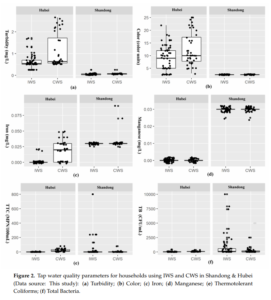 Abstract/Summary: Intermittent water supply (IWS) is a relatively common phenomenon across the world as well as in rural and peri-urban areas across China, though there has been little IWS-focused research from China published to date. IWS consumers typically adopt a range of strategies to cope with insufficient water supply, poor drinking water quality, and associated inconveniences. In this study, we collected a range of data from small-scale utilities and households in two IWS systems and two continuous water supply (CWS) systems, as well as from comparison groups, in Shandong and Hubei provinces. Data collection included water quality testing, interviews, and surveys on behavioral adaptations, coping strategies, water-related health perceptions, and other metrics of consumer satisfaction. Overall, we found that the IWS coping strategies employed in northern China (Shandong) were associated with generally safe, but inconvenient, water access, whereas adaptation strategies observed in southern China (Hubei) appeared to improve convenience, but not water quality. Compared to the CWS comparison groups, we did not observe significant differences in waterand sanitation-related behaviors in the IWS groups, suggesting interventions to increase adaptive and protective behaviors at the household level might further improve safe water access for households living with IWS. Overall, although the water supply infrastructure in these study areas appeared to be in relatively good condition, in contrast to reported data on IWS systems in other countries, we observed multiple risk factors associated with the water treatment and distribution processes in these IWS systems. Among policy recommendations, our results suggest that the implementation of Water Safety Plans in China would likely improve the management of drinking water treatment and, by extension, safe drinking water supply under conditions of IWS.
Abstract/Summary: Intermittent water supply (IWS) is a relatively common phenomenon across the world as well as in rural and peri-urban areas across China, though there has been little IWS-focused research from China published to date. IWS consumers typically adopt a range of strategies to cope with insufficient water supply, poor drinking water quality, and associated inconveniences. In this study, we collected a range of data from small-scale utilities and households in two IWS systems and two continuous water supply (CWS) systems, as well as from comparison groups, in Shandong and Hubei provinces. Data collection included water quality testing, interviews, and surveys on behavioral adaptations, coping strategies, water-related health perceptions, and other metrics of consumer satisfaction. Overall, we found that the IWS coping strategies employed in northern China (Shandong) were associated with generally safe, but inconvenient, water access, whereas adaptation strategies observed in southern China (Hubei) appeared to improve convenience, but not water quality. Compared to the CWS comparison groups, we did not observe significant differences in waterand sanitation-related behaviors in the IWS groups, suggesting interventions to increase adaptive and protective behaviors at the household level might further improve safe water access for households living with IWS. Overall, although the water supply infrastructure in these study areas appeared to be in relatively good condition, in contrast to reported data on IWS systems in other countries, we observed multiple risk factors associated with the water treatment and distribution processes in these IWS systems. Among policy recommendations, our results suggest that the implementation of Water Safety Plans in China would likely improve the management of drinking water treatment and, by extension, safe drinking water supply under conditions of IWS.
PDF on Publisher Website | PDF on OSF
The impacts of socioeconomic development on rural drinking water safety in China: A provincial-level comparative analysis
Authors: Li, H., Cohen, A., Li, Z., & Zhang, M.
Publication Year: 2019 | Journal / Publisher: Sustainability
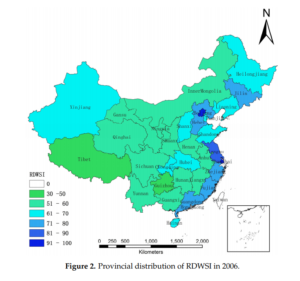 Abstract/Summary:In China, achieving rural drinking water safety—meaning access to a safe, affordable, sufficient, and sustainable drinking water supply—remains a key challenge for government agencies and researchers. Using cross-sectional data at the provincial level, in this paper we examine the impacts of socioeconomic development on drinking water safety in rural China. Using a theoretical framework called Pressure-State-Response (PSR), existing data were organized into state and pressure indicators. Canonical Correlation Analysis was then used to analyze provincial-level relationships between the indicators. Significant drinking-water-safety-related differences were found across provinces. Our analyses suggest that, overall, China’s recent and rapid socioeconomic development yielded substantial benefits for China’s rural drinking water safety. However, this same development also negatively impacted rural drinking water safety via increased groundwater over-abstraction, reductions in water supply, and environmental contamination. The paper closes with a discussion of implications and options for improving drinking water policy, management, and regulation in rural China.
Abstract/Summary:In China, achieving rural drinking water safety—meaning access to a safe, affordable, sufficient, and sustainable drinking water supply—remains a key challenge for government agencies and researchers. Using cross-sectional data at the provincial level, in this paper we examine the impacts of socioeconomic development on drinking water safety in rural China. Using a theoretical framework called Pressure-State-Response (PSR), existing data were organized into state and pressure indicators. Canonical Correlation Analysis was then used to analyze provincial-level relationships between the indicators. Significant drinking-water-safety-related differences were found across provinces. Our analyses suggest that, overall, China’s recent and rapid socioeconomic development yielded substantial benefits for China’s rural drinking water safety. However, this same development also negatively impacted rural drinking water safety via increased groundwater over-abstraction, reductions in water supply, and environmental contamination. The paper closes with a discussion of implications and options for improving drinking water policy, management, and regulation in rural China.
PDF on Publisher Website | PDF on OSF
Fuel use trends for boiling water in rural China (1992-2012) & environmental health implications: A national cross-sectional study
Authors: Du, W., Cohen, A., Shen, G., Ru, M., Shen, H., & Shu, T.
Publication Year: 2018 | Journal / Publisher: Environmental Science & Technology
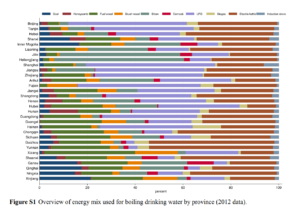 Abstract/Summary:Survey data from a comprehensive national survey of ∼34 000 households were analyzed for the mix status and transition trajectory of energy for boiling water in rural Chinese households from 1992 to 2012. In 1992, ∼6% of households reported using electricity, biogas, or liquefied petroleum gas (LPG) to boil drinking water; in 2012, the proportion was ∼60%. Income per capita appeared most strongly associated with this transition toward electricity and other clean fuels. Median annual incomes for households using biomass fuels, electric kettles, and LPG were RMB 15 000, 28 000, and 30 000, respectively. Overall, the transition was most pronounced in eastern China, a region which experienced relatively higher rates of economic growth over the same 20-year period. Energy type preferences appear to be highly dependent on fuel accessibility such that coal and straw usage was higher in provinces with higher coal and grain production. These trends suggest that electric kettle use would likely increase from ∼29% (2012) to ∼60% by 2030, at which point <5% of rural households would be expected to boil with solid fuels. Recent evidence suggests that this transition could contribute to reductions in water-related gastrointestinal illness as well as reductions in air pollutant emissions in rural China.
Abstract/Summary:Survey data from a comprehensive national survey of ∼34 000 households were analyzed for the mix status and transition trajectory of energy for boiling water in rural Chinese households from 1992 to 2012. In 1992, ∼6% of households reported using electricity, biogas, or liquefied petroleum gas (LPG) to boil drinking water; in 2012, the proportion was ∼60%. Income per capita appeared most strongly associated with this transition toward electricity and other clean fuels. Median annual incomes for households using biomass fuels, electric kettles, and LPG were RMB 15 000, 28 000, and 30 000, respectively. Overall, the transition was most pronounced in eastern China, a region which experienced relatively higher rates of economic growth over the same 20-year period. Energy type preferences appear to be highly dependent on fuel accessibility such that coal and straw usage was higher in provinces with higher coal and grain production. These trends suggest that electric kettle use would likely increase from ∼29% (2012) to ∼60% by 2030, at which point <5% of rural households would be expected to boil with solid fuels. Recent evidence suggests that this transition could contribute to reductions in water-related gastrointestinal illness as well as reductions in air pollutant emissions in rural China.
PDF on Publisher Website | PDF on OSF
The global risks of increasing reliance on bottled water
Authors: Alasdair Cohen and Isha Ray
Publication Year: 2018 | Journal / Publisher: Nature Sustainability
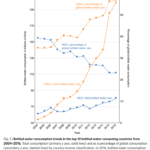 Abstract/Summary: The rapid growth of bottled water use in low- and middle-income countries, and its normalization as a daily source of drinking water, does not provide a pathway to universal access. Generous and sustained investment in centralized and community utilities remains the most viable means for achieving safe water access for all. We recommend that the international development community and LMIC governments accept that full-cost recovery from a low-income customer base is not realistic, and that they actively invest in regulated utilities or community-scale models as the most sustainable options for delivering universal safe water access. This will take time, of course. Consumer confidence in the safety of utility supplied water should be fortified along the way with water quality reports and, perhaps, ‘marketing’ messages. These recommendations are not new, but they bear repeating in an era of explosive growth in, and de facto normalization of, market-driven approaches to ‘safe water for all’. In the meantime, non-tap treatment options that are known to be effective and affordable, but that may achieve only partial uptake, should be subsidized and more aggressively promoted. If, on the other hand, governments and development agencies allow the bottled water sector to continue meeting the rising demand for safe water in LMICs, then access will indeed expand by 2030, but it will not be reliably safe or universally affordable. The SDG for drinking water is a public commitment, and history is clear: public commitments need public investment.
Abstract/Summary: The rapid growth of bottled water use in low- and middle-income countries, and its normalization as a daily source of drinking water, does not provide a pathway to universal access. Generous and sustained investment in centralized and community utilities remains the most viable means for achieving safe water access for all. We recommend that the international development community and LMIC governments accept that full-cost recovery from a low-income customer base is not realistic, and that they actively invest in regulated utilities or community-scale models as the most sustainable options for delivering universal safe water access. This will take time, of course. Consumer confidence in the safety of utility supplied water should be fortified along the way with water quality reports and, perhaps, ‘marketing’ messages. These recommendations are not new, but they bear repeating in an era of explosive growth in, and de facto normalization of, market-driven approaches to ‘safe water for all’. In the meantime, non-tap treatment options that are known to be effective and affordable, but that may achieve only partial uptake, should be subsidized and more aggressively promoted. If, on the other hand, governments and development agencies allow the bottled water sector to continue meeting the rising demand for safe water in LMICs, then access will indeed expand by 2030, but it will not be reliably safe or universally affordable. The SDG for drinking water is a public commitment, and history is clear: public commitments need public investment.
PDF on Publisher Website | PDF on OSF
Effects of boiling drinking water on diarrhea & pathogen-specific infections in low- & middle-income countries: A systematic review & meta-analysis
Authors: Cohen, A. & Colford, J. M.
Publication Year: 2017 | Journal / Publisher: American Journal of Tropical Medicine & Hygiene
 Abstract/Summary: Globally, approximately 2 billion people lack microbiologically safe drinking water. Boiling is the most prevalent household water treatment method, yet evidence of its health impact is limited. To conduct this systematic review, we searched four online databases with no limitations on language or publication date. Studies were eligible if health outcomes were measured for participants who reported consuming boiled and untreated water. We used reported and calculated odds ratios (ORs) and random-effects meta-analysis to estimate pathogen-specific and pooled effects by organism group and nonspecific diarrhea. Heterogeneity and publication bias were assessed using I2, meta-regression, and funnel plots; study quality was also assessed. Of the 1,998 records identified, 27 met inclusion criteria and reported extractable data. We found evidence of a significant protective effect of boiling for Vibrio cholerae infections (OR = 0.31, 95% confidence interval [CI] = 0.13–0.79, N = 4 studies), Blastocystis (OR = 0.35, 95% CI = 0.17–0.69, N = 3), protozoal infections overall (pooled OR = 0.61, 95% CI = 0.43–0.86, N = 11), viral infections overall (pooled OR = 0.83, 95% CI =0.7–0.98, N = 4), and nonspecific diarrheal outcomes (OR = 0.58, 95% CI = 0.45–0.77, N = 7). We found no evidence of a protective effect for helminthic infections. Although our study was limited by the use of self-reported boiling and non-experimental designs, the evidence suggests that boiling provides measurable health benefits for pathogens whose transmission routes are primarily water based. Consequently, we believe a randomized controlled trial of boiling adherence and health outcomes is needed.
Abstract/Summary: Globally, approximately 2 billion people lack microbiologically safe drinking water. Boiling is the most prevalent household water treatment method, yet evidence of its health impact is limited. To conduct this systematic review, we searched four online databases with no limitations on language or publication date. Studies were eligible if health outcomes were measured for participants who reported consuming boiled and untreated water. We used reported and calculated odds ratios (ORs) and random-effects meta-analysis to estimate pathogen-specific and pooled effects by organism group and nonspecific diarrhea. Heterogeneity and publication bias were assessed using I2, meta-regression, and funnel plots; study quality was also assessed. Of the 1,998 records identified, 27 met inclusion criteria and reported extractable data. We found evidence of a significant protective effect of boiling for Vibrio cholerae infections (OR = 0.31, 95% confidence interval [CI] = 0.13–0.79, N = 4 studies), Blastocystis (OR = 0.35, 95% CI = 0.17–0.69, N = 3), protozoal infections overall (pooled OR = 0.61, 95% CI = 0.43–0.86, N = 11), viral infections overall (pooled OR = 0.83, 95% CI =0.7–0.98, N = 4), and nonspecific diarrheal outcomes (OR = 0.58, 95% CI = 0.45–0.77, N = 7). We found no evidence of a protective effect for helminthic infections. Although our study was limited by the use of self-reported boiling and non-experimental designs, the evidence suggests that boiling provides measurable health benefits for pathogens whose transmission routes are primarily water based. Consequently, we believe a randomized controlled trial of boiling adherence and health outcomes is needed.
PDF on Publisher Website | PDF on OSF
Predictors of drinking water boiling & bottled water consumption in rural China: A hierarchical modeling approach
Authors: Cohen, A., Zhang, Q., Luo, Q., Tao, Y., Colford, J. M., & Ray, I.
Publication Year: 2017 | Journal / Publisher: Environmental Science & Technology
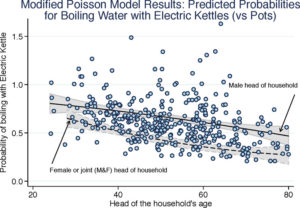 Abstract/Summary: Approximately two billion people drink unsafe water. Boiling is the most commonly used household water treatment (HWT) method globally and in China. HWT can make water safer, but sustained adoption is rare and bottled water consumption is growing. To successfully promote HWT, an understanding of associated socioeconomic factors is critical. We collected survey data and water samples from 450 rural households in Guangxi Province, China. Covariates were grouped into blocks to hierarchically construct modified Poisson models and estimate risk ratios (RR) associated with boiling methods, bottled water, and untreated water. Female-headed households were most likely to boil (RR = 1.36, p < 0.01), and among boilers those using electric kettles rather than pots had higher income proxies (e.g., per capita TV ownership RR = 1.42, p < 0.01). Higher-income households with younger, literate, and male heads were more likely to purchase (frequently contaminated) bottled water, or use electric kettles if they boiled. Our findings show that boiling is not an undifferentiated practice, but one with different methods of varying effectiveness, environmental impact, and adoption across socioeconomic strata. Our results can inform programs to promote safer and more efficient boiling using electric kettles, and suggest that if rural China’s economy continues to grow then bottled water use will increase.
Abstract/Summary: Approximately two billion people drink unsafe water. Boiling is the most commonly used household water treatment (HWT) method globally and in China. HWT can make water safer, but sustained adoption is rare and bottled water consumption is growing. To successfully promote HWT, an understanding of associated socioeconomic factors is critical. We collected survey data and water samples from 450 rural households in Guangxi Province, China. Covariates were grouped into blocks to hierarchically construct modified Poisson models and estimate risk ratios (RR) associated with boiling methods, bottled water, and untreated water. Female-headed households were most likely to boil (RR = 1.36, p < 0.01), and among boilers those using electric kettles rather than pots had higher income proxies (e.g., per capita TV ownership RR = 1.42, p < 0.01). Higher-income households with younger, literate, and male heads were more likely to purchase (frequently contaminated) bottled water, or use electric kettles if they boiled. Our findings show that boiling is not an undifferentiated practice, but one with different methods of varying effectiveness, environmental impact, and adoption across socioeconomic strata. Our results can inform programs to promote safer and more efficient boiling using electric kettles, and suggest that if rural China’s economy continues to grow then bottled water use will increase.
PDF on Publisher Website | PDF on OSF
Microbiological evaluation of household drinking water treatment in rural China shows benefits of electric kettles: A cross-sectional study
Authors: Cohen, A., Tao, Y., Luo, Q., Zhong, G., Romm, J., Colford, J. M., & Ray, I.
Publication Year: 2015 | Journal / Publisher: PLoS ONE
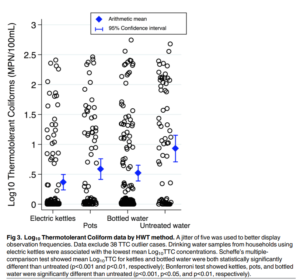 Abstract: Background – In rural China ~607 million people drink boiled water, yet little is known about prevailing household water treatment (HWT) methods or their effectiveness. Boiling, the most common HWT method globally, is microbiologically effective, but household air pollution (HAP) from burning solid fuels causes cardiovascular and respiratory disease, and black carbon emissions exacerbate climate change. Boiled water is also easily re-contaminated. Our study was designed to identify the HWT methods used in rural China and to evaluate their effectiveness. Methods – We used a geographically stratified cross-sectional design in rural Guangxi Province to collect survey data from 450 households in the summer of 2013. Household drinking water samples were collected and assayed for Thermotolerant Coliforms (TTC), and physicochemical analyses were conducted for village drinking water sources. In the winter of 2013–2104, we surveyed 120 additional households and used remote sensors to corroborate selfreported boiling data. Findings – Our HWT prevalence estimates were: 27.1% boiling with electric kettles, 20.3% boiling with pots, 34.4% purchasing bottled water, and 18.2% drinking untreated water (for these analyses we treated bottled water as a HWT method). Households using electric kettles had the lowest concentrations of TTC (73% lower than households drinking untreated water). Multilevel mixed-effects regression analyses showed that electric kettles were associated with the largest Log10TTC reduction (-0.60, p<0.001), followed by bottled water (-0.45, p<0.001) and pots (-0.44, p<0.01). Compared to households drinking untreated water, electric kettle users also had the lowest risk of having TTC detected in their drinking water (risk ratio, RR = 0.49, 0.34–0.70, p<0.001), followed by bottled water users (RR = 0.70, 0.53–0.93, p<0.05) and households boiling with pots (RR = 0.74, 0.54–1.02, p = 0.06). Conclusion: As far as we are aware, this is the first HWT-focused study in China, and the first to quantify the comparative advantage of boiling with electric kettles over pots. Our results suggest that electric kettles could be used to rapidly expand safe drinking water access and reduce HAP exposure in rural China.
Abstract: Background – In rural China ~607 million people drink boiled water, yet little is known about prevailing household water treatment (HWT) methods or their effectiveness. Boiling, the most common HWT method globally, is microbiologically effective, but household air pollution (HAP) from burning solid fuels causes cardiovascular and respiratory disease, and black carbon emissions exacerbate climate change. Boiled water is also easily re-contaminated. Our study was designed to identify the HWT methods used in rural China and to evaluate their effectiveness. Methods – We used a geographically stratified cross-sectional design in rural Guangxi Province to collect survey data from 450 households in the summer of 2013. Household drinking water samples were collected and assayed for Thermotolerant Coliforms (TTC), and physicochemical analyses were conducted for village drinking water sources. In the winter of 2013–2104, we surveyed 120 additional households and used remote sensors to corroborate selfreported boiling data. Findings – Our HWT prevalence estimates were: 27.1% boiling with electric kettles, 20.3% boiling with pots, 34.4% purchasing bottled water, and 18.2% drinking untreated water (for these analyses we treated bottled water as a HWT method). Households using electric kettles had the lowest concentrations of TTC (73% lower than households drinking untreated water). Multilevel mixed-effects regression analyses showed that electric kettles were associated with the largest Log10TTC reduction (-0.60, p<0.001), followed by bottled water (-0.45, p<0.001) and pots (-0.44, p<0.01). Compared to households drinking untreated water, electric kettle users also had the lowest risk of having TTC detected in their drinking water (risk ratio, RR = 0.49, 0.34–0.70, p<0.001), followed by bottled water users (RR = 0.70, 0.53–0.93, p<0.05) and households boiling with pots (RR = 0.74, 0.54–1.02, p = 0.06). Conclusion: As far as we are aware, this is the first HWT-focused study in China, and the first to quantify the comparative advantage of boiling with electric kettles over pots. Our results suggest that electric kettles could be used to rapidly expand safe drinking water access and reduce HAP exposure in rural China.
PDF on Publisher Website | PDF on OSF
The Multidimensional Poverty Assessment Tool: Brochure (& Infographics)
Authors: IFAD [Cohen, A.]
Publication Year: 2014 | Journal / Publisher: United Nations International Fund for Agricultural Development
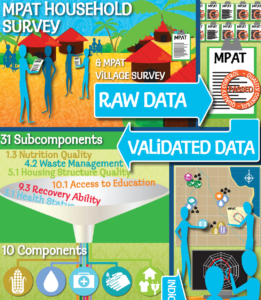 Abstract/Summary: The Multidimensional Poverty Assessment Tool (MPAT) provides data that can inform all levels of decision making by providing a clearer understanding of rural poverty at the household and village level. As a result, MPAT can significantly strengthen the planning, design, monitoring and evaluation of a project, and thereby contribute to rural poverty reduction.
Abstract/Summary: The Multidimensional Poverty Assessment Tool (MPAT) provides data that can inform all levels of decision making by providing a clearer understanding of rural poverty at the household and village level. As a result, MPAT can significantly strengthen the planning, design, monitoring and evaluation of a project, and thereby contribute to rural poverty reduction.
This brochure explains:
-
- What MPAT is
- How MPAT works
- When to use MPAT and why
- How to use MPAT
- What resources are available for implementing MPAT
The tool allows project managers, government officials, researchers and others to identify and monitor sectors that require support in order to reduce rural poverty and improve livelihoods. It also provides an objective means of justifying resource allocation or planning priorities. MPAT is based on a bottom-up, participatory approach that reflects communities’ voices, wants and perspectives.
PDF on Publisher Website | PDF on OSF
The Multidimensional Poverty Assessment Tool: User’s Guide
Authors: IFAD [Cohen, A. & Jayne, S.]
Publication Year: 2014 | Journal / Publisher: United Nations International Fund for Agricultural Development
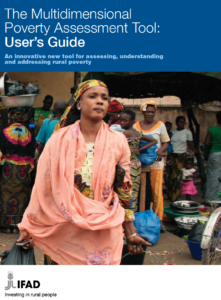 Abstract/Summary: The Multidimensional Poverty Assessment Tool (MPAT) provides a method for simplifying the complexity of rural poverty in order to support poverty alleviation efforts. MPAT uses thoroughly designed and tested purpose-built surveys to collect data on people’s perceptions about fundamental and interconnected aspects of their lives, livelihoods and environments. Standardized indicators, developed through a comprehensive participatory process, are then employed to combine, distil and present these data in an accessible way. MPAT was developed through a participatory, collaborative process based on expert feedback from dozens of international development experts from IFAD, other United Nations agencies, international and regional organizations, and universities from around the world. It was field-tested in countries in both Asia and Africa. In the pages that follow, we explain what MPAT is, how it works and how it is used, providing step-by-step instructions, training materials and other resources. The ultimate objective of this User’s Guide and the accompanying Excel Spreadsheet is to make MPAT a truly free and open-source tool, so that any institution or agency, big or small, may implement MPAT on its own.
Abstract/Summary: The Multidimensional Poverty Assessment Tool (MPAT) provides a method for simplifying the complexity of rural poverty in order to support poverty alleviation efforts. MPAT uses thoroughly designed and tested purpose-built surveys to collect data on people’s perceptions about fundamental and interconnected aspects of their lives, livelihoods and environments. Standardized indicators, developed through a comprehensive participatory process, are then employed to combine, distil and present these data in an accessible way. MPAT was developed through a participatory, collaborative process based on expert feedback from dozens of international development experts from IFAD, other United Nations agencies, international and regional organizations, and universities from around the world. It was field-tested in countries in both Asia and Africa. In the pages that follow, we explain what MPAT is, how it works and how it is used, providing step-by-step instructions, training materials and other resources. The ultimate objective of this User’s Guide and the accompanying Excel Spreadsheet is to make MPAT a truly free and open-source tool, so that any institution or agency, big or small, may implement MPAT on its own.
PDF on Publisher Website | PDF on OSF
Water & poverty in rural China: Developing an instrument to assess the multiple dimensions of water & poverty
Authors: Cohen, A. & Sullivan, C.
Publication Year: 2010 | Journal / Publisher: Ecological Economics
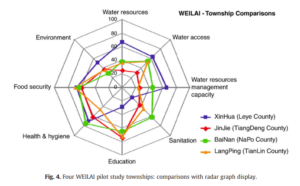 Abstract/Summary: This paper describes the theoretical foundations and development of a multidimensional, water-focused, thematic indicator of rural poverty: The Water, Economy, Investment and Learning Assessment Indicator (WEILAI). The WEILAI approach was specifically designed for application in rural China, to support poverty alleviation project planning, monitoring and evaluation, as well as targeting and prioritization. WEILAI builds primarily on the basic needs framework of poverty alleviation, and on the methodological structure of the Water Poverty Index, to provide a proxy measure of an area’s poverty by assessing eight key poverty sectors, with a strong focus on the components of water-poverty. The WEILAI approach was piloted and implemented in 534 households in China’s mountainous southwest. This paper describes the indicator construction, weighting schemes, methodology, field sites, and statistical validation of the results. In addition, we discuss the results, feedback from in-country project staff, and the likely utility of the tool for project planning, monitoring and evaluation support. The paper concludes with a discussion of WEILAI’s overall utility and ongoing development.
Abstract/Summary: This paper describes the theoretical foundations and development of a multidimensional, water-focused, thematic indicator of rural poverty: The Water, Economy, Investment and Learning Assessment Indicator (WEILAI). The WEILAI approach was specifically designed for application in rural China, to support poverty alleviation project planning, monitoring and evaluation, as well as targeting and prioritization. WEILAI builds primarily on the basic needs framework of poverty alleviation, and on the methodological structure of the Water Poverty Index, to provide a proxy measure of an area’s poverty by assessing eight key poverty sectors, with a strong focus on the components of water-poverty. The WEILAI approach was piloted and implemented in 534 households in China’s mountainous southwest. This paper describes the indicator construction, weighting schemes, methodology, field sites, and statistical validation of the results. In addition, we discuss the results, feedback from in-country project staff, and the likely utility of the tool for project planning, monitoring and evaluation support. The paper concludes with a discussion of WEILAI’s overall utility and ongoing development.
PDF on Publisher Website | PDF on OSF
InnoWat: IFAD & rural water investments
Authors: Cohen, A. & Nepveu de Villemarceau, A.
Publication Year: 2009 | Journal / Publisher: Rome: United Nations International Fund for Agricultural Development
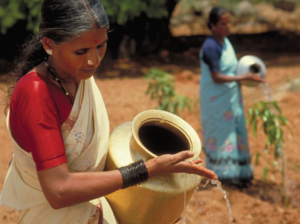 IFAD is currently engaged in over 230 loan operations in 85 countries. About two thirds of that portfolio is related to community-based natural resource management. Poor rural people and their institutions are at the core of this approach. Water is critical to these men and women pastoralists, fishers, farmers, young and old, part- or full-time, urban or rural, indigenous, tribal or otherwise often marginalized people. Itis the key entry point for improving their livelihoods. Water-related interventions are often linked to the building up or restoring of the asset base – and involve many facets and uses. This holistic view is part of the characterization of IFAD’s approach to water interventions in this fact sheet: rather than considering water solely as an input factor in the production chain, we have preferred to follow water throughout rural people’s livelihoods. This approach, combined with a qualitative analysis of the ongoing 2007/08 loan portfolio, yielded a few surprising insights (table 1).Almost half of all projects (45-50 per cent) involve aspects of water resource management at catchment or watershed levels, and hence beyond the immediate household or community level of use.
IFAD is currently engaged in over 230 loan operations in 85 countries. About two thirds of that portfolio is related to community-based natural resource management. Poor rural people and their institutions are at the core of this approach. Water is critical to these men and women pastoralists, fishers, farmers, young and old, part- or full-time, urban or rural, indigenous, tribal or otherwise often marginalized people. Itis the key entry point for improving their livelihoods. Water-related interventions are often linked to the building up or restoring of the asset base – and involve many facets and uses. This holistic view is part of the characterization of IFAD’s approach to water interventions in this fact sheet: rather than considering water solely as an input factor in the production chain, we have preferred to follow water throughout rural people’s livelihoods. This approach, combined with a qualitative analysis of the ongoing 2007/08 loan portfolio, yielded a few surprising insights (table 1).Almost half of all projects (45-50 per cent) involve aspects of water resource management at catchment or watershed levels, and hence beyond the immediate household or community level of use.
PDF on Publisher Website | PDF on OSF
The Multidimensional Poverty Assessment Tool: Design, development & application of a new framework for measuring rural poverty
Authors: Cohen, A.
Publication Year: 2009 | Journal / Publisher: United Nations International Fund for Agricultural Development
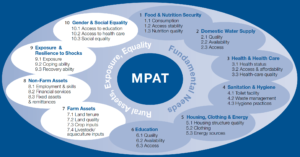 Abstract/Summary: The purpose of this book is to describe the theoretical foundations upon which the Multidimensional Poverty Assessment Tool (MPAT) was built, to tell the story of how it was created, developed, tested and piloted in rural China and India, and to explain how MPAT can be used to benefit rural communities around the world. Lasting poverty alleviation is achieved by fostering a comprehensive enabling environment within which people have a sufficiently high level of well-being and are able to pursue their livelihood goals based on their aspirations and initiative. To ensure that such environments are in place requires, at a minimum, an understanding of the key constraints rural people face – the fundamental dimensions central to their lives and livelihoods. MPAT does not try to define rural poverty per se; rather it takes a step back from assessment modalities that are overly focused on economic- and consumption-oriented indicators and strives to provide an overview of fundamental and relatively universal dimensions germane to rural livelihoods, rural life, and thus to rural poverty. By summarizing rural communities’ perceptions about key dimensions of rural poverty and focusing them through a quantitative lens, MPAT transparently illuminates problem areas so that all stakeholders can see where deficiencies lie and can begin to discuss which interventions may be most appropriate to address them, based on the local context.
Abstract/Summary: The purpose of this book is to describe the theoretical foundations upon which the Multidimensional Poverty Assessment Tool (MPAT) was built, to tell the story of how it was created, developed, tested and piloted in rural China and India, and to explain how MPAT can be used to benefit rural communities around the world. Lasting poverty alleviation is achieved by fostering a comprehensive enabling environment within which people have a sufficiently high level of well-being and are able to pursue their livelihood goals based on their aspirations and initiative. To ensure that such environments are in place requires, at a minimum, an understanding of the key constraints rural people face – the fundamental dimensions central to their lives and livelihoods. MPAT does not try to define rural poverty per se; rather it takes a step back from assessment modalities that are overly focused on economic- and consumption-oriented indicators and strives to provide an overview of fundamental and relatively universal dimensions germane to rural livelihoods, rural life, and thus to rural poverty. By summarizing rural communities’ perceptions about key dimensions of rural poverty and focusing them through a quantitative lens, MPAT transparently illuminates problem areas so that all stakeholders can see where deficiencies lie and can begin to discuss which interventions may be most appropriate to address them, based on the local context.
PDF on Publisher Website | PDF on OSF
The Rural Water Livelihoods Index. Working Paper
Authors: Sullivan, C., Cohen, A., Faurès, J. M., & Santini, G.
Publication Year: 2008 | Journal / Publisher: Food & Agriculture Organization of the United Nations
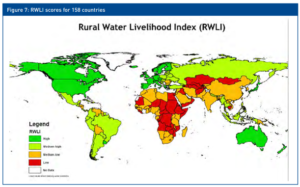 Abstract/Summary: The Rural Water Livelihood Index (RWLI) is calculated on the basis of components and indicator values representing each of these four dimensions. The resulting composite index reflects the values for these four dimensions, and on this basis, judgements can be made on how water management might be improved. Each of the four dimensions (components) of the RWLI are represented by two subcomponents, which are combined using a weighted average. In this report, this framework is applied at the national scale, but the approach can be used at any scale as long as appropriate data is available. The purpose of the RWLI is to provide policy makers and planners at the national level an overview of where their country stands relative to others (much like the Human Development Index), and relative to themselves over time, to examine and monitor progress being made as a result of actions taken. This in turn will hopefully allow for better targeted water related interventions to improve rural livelihoods. Through the measurement of these key components, it will be possible to assess which of the four dimensions are most likely to benefit from interventions. Appropriate interventions are context-specific and will have to be identified on a country-by-country basis since contexts differ so widely (i.e., responses to address the reported states will be country and site-specific). However, a general Response Matrix is being developed to provide planners and policy makers a conceptual framework to guide this process and at a macro-level the index values help national-level planners identify which sectors might be most in need of assistance.
Abstract/Summary: The Rural Water Livelihood Index (RWLI) is calculated on the basis of components and indicator values representing each of these four dimensions. The resulting composite index reflects the values for these four dimensions, and on this basis, judgements can be made on how water management might be improved. Each of the four dimensions (components) of the RWLI are represented by two subcomponents, which are combined using a weighted average. In this report, this framework is applied at the national scale, but the approach can be used at any scale as long as appropriate data is available. The purpose of the RWLI is to provide policy makers and planners at the national level an overview of where their country stands relative to others (much like the Human Development Index), and relative to themselves over time, to examine and monitor progress being made as a result of actions taken. This in turn will hopefully allow for better targeted water related interventions to improve rural livelihoods. Through the measurement of these key components, it will be possible to assess which of the four dimensions are most likely to benefit from interventions. Appropriate interventions are context-specific and will have to be identified on a country-by-country basis since contexts differ so widely (i.e., responses to address the reported states will be country and site-specific). However, a general Response Matrix is being developed to provide planners and policy makers a conceptual framework to guide this process and at a macro-level the index values help national-level planners identify which sectors might be most in need of assistance.
PDF on Publisher Website | PDF on OSF

